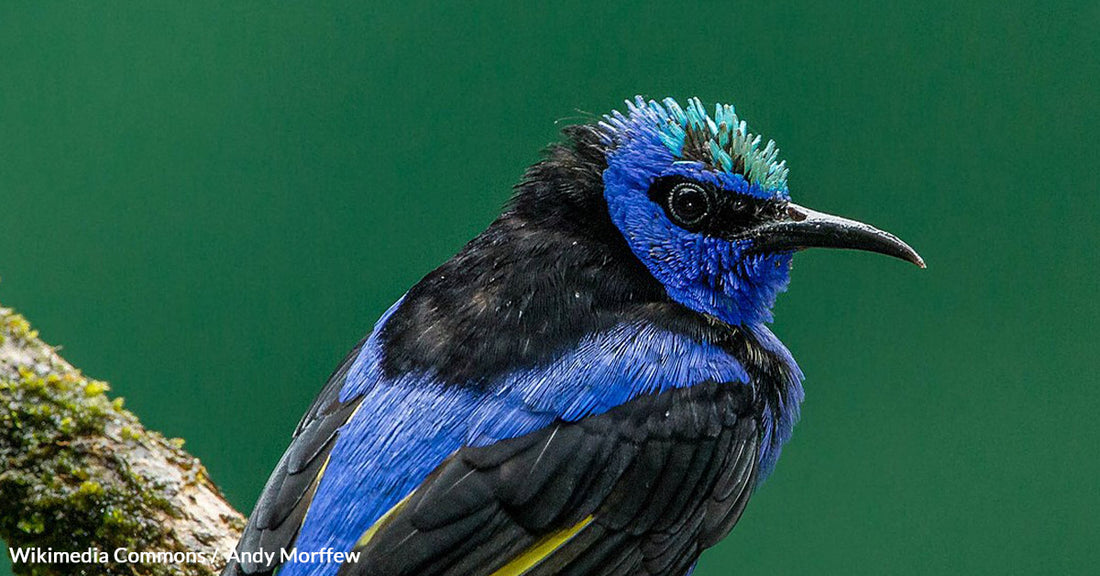Millions of Mosquitoes May Be The Only Hope To Save Hawaii's Honeycreepers
Matthew Russell
The picturesque archipelago of Hawaii, with its vibrant flora and fauna, is home to a group of avian treasures known as honeycreepers. These brightly colored birds, descendants of finches that arrived over millions of years ago, are at the heart of Hawaiian culture and ecosystems.
However, the honeycreepers are facing a dire threat to their survival, and time is running out. The culprits? Invasive mosquitoes and avian malaria.
Now, a groundbreaking solution could give these unique birds a fighting chance: the Incompatible Insect Technique (IIT).
 Photo: Purple Honeycreeper (Cyanerpes caeruleus) (4687345569), Wikimedia Commons / Dominic Sherony, License: CC BY-SA 2.0 DEED
Photo: Purple Honeycreeper (Cyanerpes caeruleus) (4687345569), Wikimedia Commons / Dominic Sherony, License: CC BY-SA 2.0 DEEDPreserving honeycreepers is not just about saving a species but also safeguarding Hawaii's unique ecosystems.
Honeycreepers: Symbols of Hawaii
The honeycreepers are more than just birds; they are integral to Hawaii's culture and environment. Once, over 50 species of these avian jewels graced the islands, but today, only 17 remain, according to data from the U.S. Geological Survey. Introduced predators, habitat destruction, and the deadly avian malaria spread by invasive Culex quinquefasciatus mosquitoes have wreaked havoc on their populations. To save these birds, an innovative approach is needed.
 Photo: Cyanerpes caeruleus Purple Honeycreeper (female) (7493732020), Wikimedia Commons / Félix Uribe, License: CC BY-SA 2.0 DEED
Photo: Cyanerpes caeruleus Purple Honeycreeper (female) (7493732020), Wikimedia Commons / Félix Uribe, License: CC BY-SA 2.0 DEEDHawaii's honeycreepers serve as an example of the challenges faced by island species with small distributions.
The Incompatible Insect Technique
As the National Park Service reports, the Incompatible Insect Technique (IIT) is a beacon of hope for honeycreepers. Traditionally used to control disease-carrying mosquitoes that affect humans, IIT is now being tailored to combat the mosquito menace that plagues the birds. The method hinges on Wolbachia bacteria, naturally found in mosquitoes' guts, which influences their ability to reproduce. The plan is to release specially bred male mosquitoes, hosting a different Wolbachia strain, into the wild. These males will mate with the local females, rendering them incapable of producing viable offspring. The mosquito population will then plummet, providing respite for the honeycreepers.
 Photo: Red-legged Honeycreeper (Cyanerpes cyaneus) in Costa Rica, Wikimedia Commons / Andy Morffew, License: CC BY-SA 2.0 DEED
Photo: Red-legged Honeycreeper (Cyanerpes cyaneus) in Costa Rica, Wikimedia Commons / Andy Morffew, License: CC BY-SA 2.0 DEED
Success with IIT depends on preventing the new Wolbachia strain from infecting local mosquitoes.
Trial by Mosquitoes
The Birds, Not Mosquitoes consortium has already conducted trial studies, releasing thousands of IIT mosquitoes to study their behavior. Results suggest that the approach works, but closer mosquito releases will be needed.
In the next phase, beginning in November, 250,000 treated mosquitoes will be dropped twice a week over approximately 3,000 acres in east Maui, Scientific American reports. These mosquitoes will be contained in biodegradable capsules. However, success depends on ensuring the new Wolbachia strain doesn't infect local mosquitoes, which would thwart the project's goals.
While the IIT approach is not a permanent solution, it offers a critical lifeline for the honeycreepers. The U.S. Department of the Interior is meanwhile establishing captive care programs, relocating at-risk honeycreepers, and developing gene drive technology to increase the birds' malaria resistance.
 Photo: Red-legged Honeycreeper RWD12b, Wikimedia Commons / DickDaniels, License: CC BY-SA 3.0 DEED
Photo: Red-legged Honeycreeper RWD12b, Wikimedia Commons / DickDaniels, License: CC BY-SA 3.0 DEEDConservation efforts for honeycreepers are a race against time, with extinction looming.
Facing the Future: An Uncertain Hope for Honeycreepers
IIT offers a beacon of hope for the honeycreepers' future, but it's only one piece of the puzzle. It will take years to eliminate mosquitoes from the islands, and a multipronged approach is necessary. Researchers are also studying how some honeycreepers have developed immunity to avian malaria, hoping to create vaccines or probiotics.
Hawaii's honeycreepers are not just canaries in the coal mine; they are a testament to our responsibility to protect the unique and fragile ecosystems that make our world so rich and diverse. The battle to save the honeycreepers is a race against time, but it's a race we must win for the sake of Hawaii's natural heritage and the planet's biodiversity.
Help us save the beautiful birds of Hawaii. Click below to ask the government to save Hawaii's beautiful bird species from extinction by continuing to support these promising efforts.

